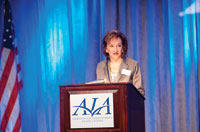Counterfeiting has been around for nearly as long as humans have traded things of value. An Aztec manuscript from the mid-16th century, for instance, cites warnings against making false cacao beans, which were used as currency. Counterfeiters made wax replicas and refilled hollow beans with sand.
Today counterfeiting affects manufacturers as well as treasuries, and is a particular concern in aerospace and defense.
 Each year aerospace products safely transport billions of passengers and billions of dollars worth of cargo. They reliably perform national security missions, protecting citizens at home and troops in the field, and maintain communications, surveillance and research capabilities in space. Their performance day in and day out is a testament to the safeguards of this industry that keep counterfeit parts from putting lives and national security at risk.
Each year aerospace products safely transport billions of passengers and billions of dollars worth of cargo. They reliably perform national security missions, protecting citizens at home and troops in the field, and maintain communications, surveillance and research capabilities in space. Their performance day in and day out is a testament to the safeguards of this industry that keep counterfeit parts from putting lives and national security at risk.
Authentic parts meet well-defined safety standards and have well-established performance histories. The performance and quality of counterfeit parts are question marks. In many applications, counterfeits may only threaten to lower sales and customer satisfaction and increase costs. In aerospace, they pose more serious threats, and we take them seriously.
This is why in 2007 the Aerospace Industries Association formed the Counterfeit Parts Integrated Project Team (IPT). That team in March issued a special report, "Counterfeit Parts: Increasing Awareness and Developing Countermeasures." Available at www.aia-aerospace.org, it offers recommendations on how the U.S. industry and government can mitigate counterfeit-parts risks and curtail their growth. They include:
Deploying a total-risk mitigation process;
Improving reporting on counterfeits, management of parts obsolescence and training of workers;
Strengthening the exchange of information about counterfeit parts and the criminal investigation of them.
Before we delve into the specific recommendations, however, let's consider the nature and scope of the counterfeiting problem.
The Counterfeit Parts IPT's membership is an indication of the problem's breadth. In addition to AIA member companies–including BAE Systems, The Boeing Company, Lockheed Martin Corporation, Parker Aerospace, Raytheon Company and Textron Inc.–the team included SAE International, the Industrial Fasteners Institute and other trade associations. Many government agencies participated, from the Defense Department and its services, agencies and commands, the FAA and NASA to the FBI, the Justice Department and the Homeland Security Department's Customs and Border Protection and Immigration and Customs Enforcement agencies.
Experts agree that counterfeit parts are a growing problem for many industries. In 2010, the Commerce Department reported that counterfeit-part incidents among electronics manufacturers increased more than 150 percent from 2005 to 2008, from 3,369 to 8,644. Its focus was military electronics; the AIA-led team concentrated on the counterfeit-electronics risk in military and civilian products. The reason is simple: electronics are integral to the function of every platform we deliver.
But the aerospace industry uses many items–fasteners, composites, adhesives and metals–that all have the potential to be counterfeited. In April, for instance, two defense contractors pled guilty to charges related to the sale of titanium falsely certified as meeting military specifications. The U.S. Attorney's Office investigating the charges said the falsely certified metal was used to make engine mounts for U.S. Air Force F-15s and parts for other Air Force aircraft and NASA's Kepler space probe, launched in 2009.
The Counterfeit Parts IPT's recommendations apply to all items that go into aerospace products, not just electronics.
Concern about counterfeit parts extends beyond aerospace. Many other industries rely on specialty metals, including construction and medicine (which also must address counterfeit drugs). Less than one percent of the world's semiconductors are used by aerospace. Far bigger users include manufacturers of automobile engine and brake controls and medical equipment, each with its own critical applications.
While there is consensus that the counterfeits problem is growing, defining its scope is difficult. Last year, the U.S. General Accountability Office assessed how well government and industry quantify the economic impact of counterfeiting in general.
"We determined that the U.S. government did not systematically collect data and perform analysis" on counterfeiting, and other tallies often are based on fragmentary or anecdotal information, the GAO told Congress. "Nonetheless, research in specific industries suggests that the problem is sizeable."
This points to a problem highlighted by the Counterfeit Parts IPT: a lack of standardized reporting. It has multiple facets, some of which are fundamental. For example, there is no commonly accepted definition of "counterfeit."
The Defense Department is hampered in determining the extent to which counterfeit parts exist "because it does not have a department-wide definition," another 2010 GAO report said. The federal Trademark Counterfeiting Act provides one definition. The FAA provides another for U.S. civil aviation. Other U.S. statutes and agencies give their own definitions.
One of the Counterfeit Parts IPT's first tasks, then, was to craft a common definition. It proposed defining a "counterfeit part" as "a product produced or altered to resemble a product without authority or right to do so, with the intent to mislead or defraud by presenting the imitation as original or genuine."
Aerospace and defense products have aspects that make them susceptible to counterfeiting. One is their long life cycles.
The U.S. Air Force B-52, for example, entered service in 1955 in a nuclear deterrence mission. It acquired new roles over the decades; now the bomber is expected to fly into 2040. It is hardly unique.
From an aircraft's initial design to retirement, original component manufacturers may go out of business or stop making components and maintaining the tooling for them. Computers used to design and support the aircraft will change nine or more times. Design software and data-storage/exchange infrastructure will change three times or more. Manufacturing processes will change two or more times. This all makes ensuring the supply of authentic parts a continual challenge.
In addressing that challenge, the AIA team focused on four areas: parts procurement, reporting of suspected counterfeits, disposition of suspect parts and management of parts obsolescence.
Policies and procedures on supplier selection present opportunities to significantly reduce the counterfeit-parts risk. Whether replacement components come from an original or new source, it is critical to know those suppliers and track their performance.
The Counterfeit Parts IPT recommends that aerospace industry members develop and manage purchasing processes like the qualified suppliers lists developed by the Defense Logistics Agency. It also recommends they adopt the SAE Aerospace Standard 5553, which outlines a total-risk mitigation process applicable to managing the supply of all aerospace components.
Reporting is crucial; it allows companies and government entities to search their inventories for suspect parts and better track supplier performance. The Government-Industry Data Exchange Program (GIDEP) is one process set up to help government and industry participants do that. In a 2008 survey, members of the Counterfeit Parts IPT and other AIA committees identified GIDEP as the predominant reporting organization, saying it can help avoid and intercept counterfeit parts discovered by others and identify suppliers associated with them.
But they said their organizations don't consistently use GIDEP for those purposes, in some cases because of liability concerns. (Subsequent to the survey, GIDEP began a pilot program that lets members opt out of identifying suppliers of known or suspected counterfeit parts to reduce legal concerns.)
The AIA team recommends that companies and the government report into a database capable of making known the extent of the counterfeit parts problem and supporting a proper response. All reports must be made as quickly after detection as possible to permit early notification so all affected parties can take steps to minimize the effect of suspect parts.
Proper disposition is essential. Counterfeit parts cannot be allowed to re-enter the supply chain after they are returned to the supplier, nor can counterfeiters be given the chance to learn how their attempts were detected and correct their mistakes.
The FAA calls for mutilating scrap parts and materials and removing their manufacturer identification, part, lot, batch and serial numbers. The AIA team recommends that companies develop their own disposition plans and that the government develop guidance on disposing of such material for industry.
Obsolescence can be reduced by industry and the government working to better predict when components will start being phased out and developing alternate sources of supply. The AIA team recommends that industry members review the Defense Department publication, "Diminishing Manufacturing Sources and Material Shortages, A Guidebook of Best Practices and Tools."
The members of AIA are committed to strengthening aerospace's safeguards against the counterfeit-parts threat and ensuring that our military and civil customers can continue to operate our products safely, reliably and with the highest level of confidence. We strongly believe that these recommendations form the basis for collective solutions to achieve that.

